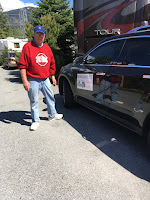 |
| Dad attaches "Alaska or Bust" sign; Motor home in background |
On May 22, 2017, I zipped up my huge suitcase, gave the
house one last careful review, and headed to O’Hare to begin the Great Alaskan Father-Daughter
Adventure. For almost three months, I traveled
with Dad through the beautiful scenery of northern Canada and Alaska. Accompanied for the first weeks by sister Mel,
we saw brown bears and bald eagles, glaciers and the midnight sun. We laughed a lot, walked a lot, cried some, and
covered many, many miles in that gorgeous Winnebago Tour -- my Dad's house on wheels.
Since my return to Chicagoland four months
ago, friends and co-workers have shaken their heads in wonder at the very idea
of three months in a motor home and the wonders of the far north.
They ask, “What
was the best thing?”
The best? From the first day out of Bothell, Washington
each turn of the highway brought something new and amazing.
- The snowy peaks that greeted us along the Sea-to-Sky highway took my breath away.
- So did the look of terror on Melanie’s face as Dad drove the 44- foot motor home up and down 13% grades with drop-off views of spring-green creek beds far, far below our side windows.
- Friendly new smiles welcomed us in Whistler when we joined up with Roger and Madeline – What could be better than meeting people who care about us just because we’re Susan and Dave’s kids? (What could be better, at my age, than to be a “kid” to someone?).
- A Pileated Woodpecker at our front door the second morning tap-tap-tapped a greeting I hope to never forget – I chose to see the bird my mom had sought and rarely seen as a blessing on our family adventure.
- The lovely clamor icy mountain falls re-initiated me to the west – where icy waters dance and romp across
glacial rocks like children at last released for summer vacation.
 |
Dad at Twin Falls
|
- At rain-soaked Hyder, we got our first glimpse of Alaska –and our first of many celebratory reunions after motor home repairs.
- Uniquely grey green glacial waters at first
surprised us and then became a familiar sign documenting the terrain through
which we traveled.
Glacial silt colors the water
of Tagish Lake - The aquamarine blue of glacial ice reflected the beaming summer sun – as seen from the back window of a tiny red airplane high above Denali.
- The whale’s tail dipping gracefully into the frozen sea.
- Puffins.
- Bellowing baleful sea lions basking like Degas’s bathers gone mad in Prince William Sound
- Fragmented tales from those who came before us
played out in cairns and roadside graffiti and mysterious messages spelled out
in stone along the highways.
Dad at Denali National Park - The Alaskan Highway
- Miles Canyon
- Denali
- Glaciers, glaciers, and glaciers.
The wonders never stopped, and I loved it all. And . . . The best thing? None of the above.
Ours was a small and pretty normal family. We played games, we watched movies, we talked politics, world events, and daily life over family dinners -- and, as all who knew her will agree, during all of those moments, Mom pretty much ran the show. Through those family events and even as an adult, I knew my dad second-hand, always filtered through the loving dominance of my mom. Without her for the first time in our family life, Dad and I had to forge a different relationship. For three months, we shared simple daily decisions -- do we breakfast on Melanie Eggs or peanut butter toast? Do we grill steaks or cheese sandwiches? Are we out of wheat thins? Classical music or bluegrass? Are we sick of Sinatra yet? We shopped -- got lost looking for the inserts to the popcorn popper, searched for motor home parts, and got carded buying booze in Alaska. Seriously. We problem-solved -- created settings for me on the driver's side of the car, replaced the air pump on the master bed, negotiated that big old bus into the alignment shop, and held the front steps together with Velcro and an old rag. We read books -- Alaska; The Call of the Wild; Wager the Wind: The Don Sheldon Story. Dad read Robert Service poems aloud and shared memories of his own dad's love for the Bard of the Yukon -- memorably reading of "The Cremation of Sam McGee" as we stood in the boat garage of the Teslin Tlingit Heritage Centre. He beat me, every time, at Gin Rummy.
Sometimes, we drove in companionable silence; sometimes, we scoured the landscape for wildlife (we slowed for "moose" that turned out to be road bikers, "bears" that we nothing more than burned out trees or large rocks). We got arrival and departure down to a science. Well -- there was the time we forgot to disconnect the hoses . . . and the time I left the brakes on in the car . . . and the time I left the car windows open . . . but other than the picnic table that got too close, we caused no harm.
My favorite place, the place I miss the most? Right there, in the passenger seat, with my dad driving the bus.
My favorite place, the place I miss the most? Right there, in the passenger seat, with my dad driving the bus.



































